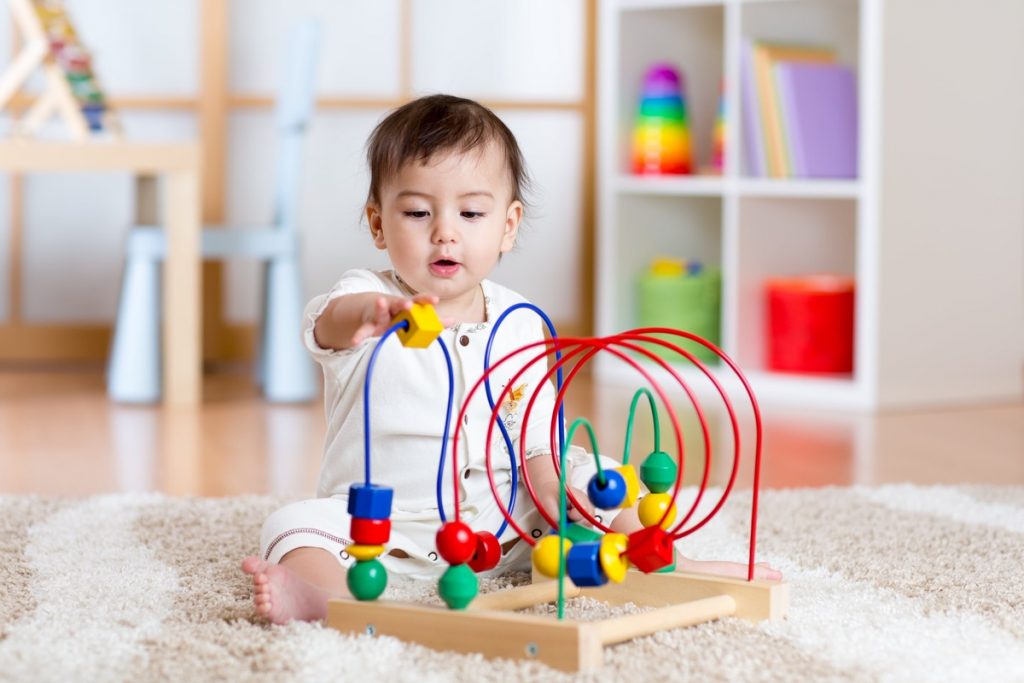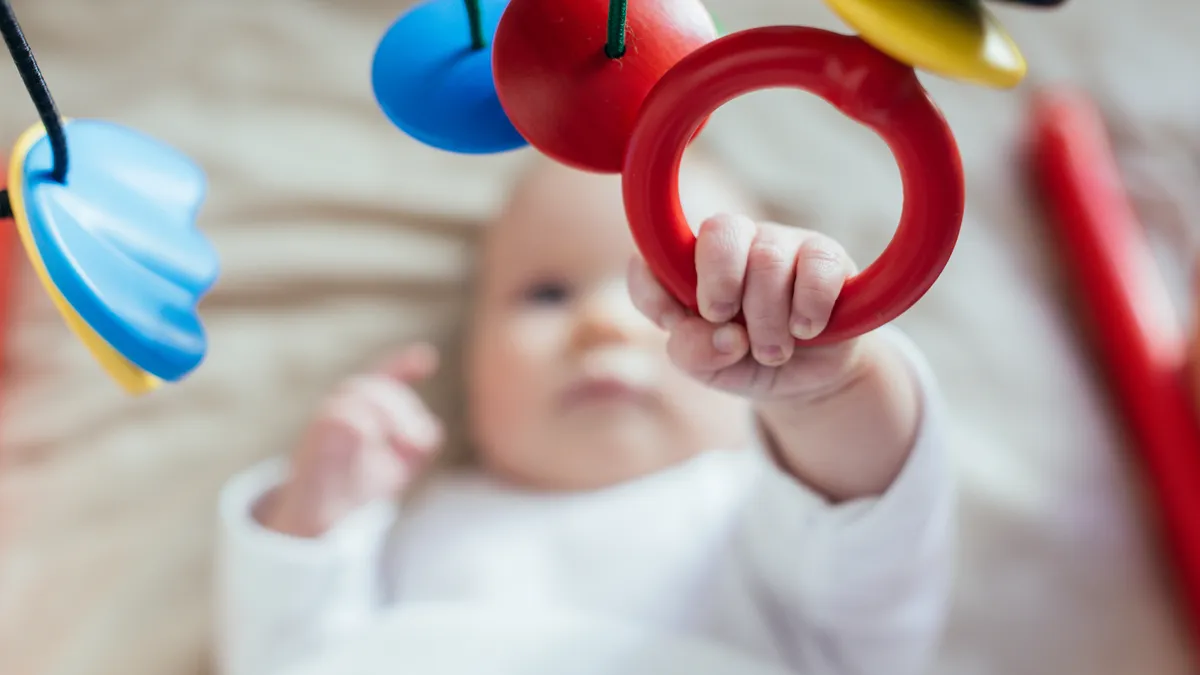A World of Wonder Unfolds: When Babies Start Playing With Toys
The arrival of a baby brings immense joy and a whirlwind of new experiences. Witnessing their growth and development is a truly remarkable journey. From gurgling newborns to curious explorers, each stage presents a unique opportunity for learning and play. Toys play a vital role in this exciting journey, nurturing a baby’s senses, cognitive abilities, and motor skills. However, many parents wonder, “When exactly do babies start playing with toys?” The answer, like most things related to babies, is not a single fixed point in time. Here, we delve into the fascinating world of baby play, exploring developmental milestones and offering tips on choosing age-appropriate toys for your little one.
The Power of Play: Why Toys Matter for Babies
While all babies benefit from social interaction and tummy time, toys specifically designed for development offer even greater advantages. Here’s a glimpse into why toys are important for babies:
Sensory Exploration:
Newborn babies experience the world primarily through their senses. Toys specifically designed for sensory exploration provide a safe and stimulating environment for them to learn and grow. Here’s a closer look:
- Visual Stimulation: High-contrast mobiles, brightly colored rattles, and soft, patterned books engage a baby’s developing vision. These visuals stimulate the optic nerve and encourage them to focus and track moving objects.
- Tactile Exploration: Soft, textured blankets, crinkly toys, and teethers with various textures provide opportunities for babies to explore touch. This tactile exploration helps them learn to differentiate between smooth, rough, soft, and hard textures, promoting sensory development.
- Auditory Stimulation: Rattles, musical mobiles, and crinkly toys introduce babies to different sounds and pitches. These auditory experiences stimulate the auditory cortex and help them develop sound recognition and discrimination skills.
Motor Skill Development:
From grasping rattles to reaching for dangling toys on an activity gym, play with toys promotes the development of both fine and gross motor skills:
- Fine Motor Skills: Grasping, holding, manipulating, and transferring objects from hand to hand all contribute to the development of fine motor skills. Stacking cups, teethers with different shapes, and soft activity books with buttons and zippers encourage these fine motor movements.
- Gross Motor Skills: Reaching for toys, kicking at playmats, and rolling over all contribute to the development of gross motor skills. Large, lightweight toys that encourage pushing, pulling, and grasping help strengthen gross motor muscles and coordination.
Cognitive Development:
While babies may not be forming complex sentences yet, play with toys lays the foundation for future cognitive development:
- Cause and Effect: Many baby toys are designed to demonstrate cause and effect. For example, shaking a rattle creates a sound, or pressing a button on a toy activates a light or melody. These experiences help babies understand that their actions can produce results, fostering early problem-solving skills.
- Object Permanence: The concept that objects continue to exist even when they can’t be seen takes time for babies to develop. Peek-a-boo games and playing with toys that “disappear” behind a blanket or come out of a container can help them grasp the concept of object permanence.
- Early Learning Concepts: Certain baby toys introduce basic concepts like shapes, colors, numbers, and animals in a playful way. These early learning experiences spark curiosity and pave the way for future learning.
A Developmental Dance: When Play Begins
While there’s no single starting point, babies begin to engage with toys in different ways as they develop, following a fascinating “developmental dance”:
Newborns (0-3 Months):
Pre-Play Stage:
While not technically playing with toys in the traditional sense, newborns engage in foundational behaviors that pave the way for future play. These include:
- Observing and Tracking: They are visually drawn to high-contrast patterns and brightly colored mobiles, following them with their eyes as they move. This visual tracking strengthens their eye muscles and coordination, preparing them for future interaction with toys.
- Reaching and Grasping Reflex: Newborns have a natural grasping reflex, which they exercise by instinctively reaching for and closing their hands around objects placed in their palms. This reflex is essential for future development of fine motor skills like grasping and manipulating toys.
- Vocalization and Sound Exploration: Newborns coo, gurgle, and babble, experimenting with their vocal cords and responding to sounds around them. These early vocalizations are the foundation for future communication and language development, which will be further fostered through playful interactions with toys.
Young Babies (3-6 Months):
Early Exploration: As their hand-eye coordination develops, babies become more intentional in their interactions with toys. They begin to:
- Reach and Grasp: They actively reach for and grasp objects, exploring their textures and shapes. This intentional grasping strengthens their hand and finger muscles and lays the foundation for future manipulation of toys.
- Mouthing and Chewing: Babies explore the world through their mouths, putting everything they can reach into their mouths. This mouthing behavior helps them learn about textures, shapes, and even tastes, while also providing comfort and teething relief.
- Cause and Effect: They begin to understand that their actions can produce results. For example, shaking a rattle creates a sound, or kicking a playmat makes a hanging toy swing. These experiences spark curiosity and encourage them to explore further, laying the groundwork for future problem-solving skills.
Curious Explorers (6-9 Months):
- Intentional Play: By this stage, babies are actively engaged in play with toys. They demonstrate:
- Object Permanence: They begin to understand that objects exist even when they can’t see them. This allows them to play peek-a-boo, search for hidden toys, and engage in pretend play with objects that represent real-life things.
- Transferring Objects: They pick up objects, transfer them from hand to hand, and explore how objects fit together or make sounds when manipulated. This object manipulation strengthens their fine motor skills and coordination.
- Problem-Solving: They experiment with toys, figuring out how to make things move, produce sounds, or achieve a desired outcome. This problem-solving through play fosters critical thinking skills and encourages exploration.
The Perfect Plaything: Choosing Age-Appropriate Toys for Your Baby
With a vast array of baby toys available, choosing the right ones can feel overwhelming. Here are some helpful tips to ensure you select toys that are safe, engaging, and promote development:
- Match the Toy to Your Baby’s Developmental Stage: Consider your baby’s current abilities and interests. Toys that are too advanced can lead to frustration, while those that are too simple won’t provide enough stimulation. Opt for toys that offer a gentle challenge and encourage exploration.
- Look for Safe and High-Quality Materials: Choose toys made from safe, non-toxic materials that are free of sharp edges or small parts that could pose a choking hazard. Look for well-constructed toys that can withstand frequent grasping, mouthing, and exploration.
- Think Sensory Stimulation: Opt for toys that incorporate a variety of textures, sounds, and colors. This multi-sensory experience engages their developing senses and keeps them interested in exploring the toy.
- Consider Open-Ended Play: Open-ended toys encourage creativity and imagination. Stacking cups can be used for building, sorting, and even bath time fun. Look for toys that can be used in multiple ways to encourage exploration and open-ended play.
Remember, the most important aspect is to play alongside your baby. Narrate your actions, sing songs, and encourage exploration. Playtime is a bonding
